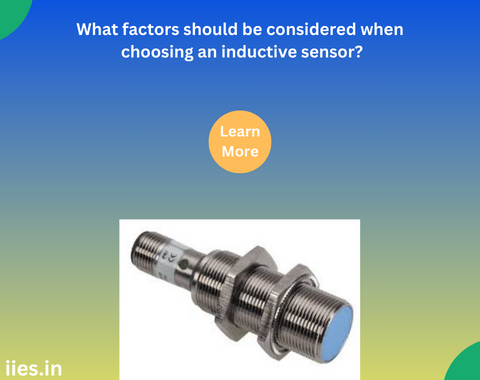
Inductive sensors are vital components in various industrial and automation applications, serving purposes such as object detection, position sensing, and proximity sensing. Choosing the right inductive sensor for a particular application is crucial for achieving optimal performance, reliability, and cost-effectiveness. Several factors need to be carefully considered to ensure the selected sensor meets the requirements of the specific application. In this article, we will explore the key factors that should be taken into account when selecting an inductive sensor.
1. Operating Environment:
The operating environment plays a significant role in determining the suitability of an inductive sensor. Factors such as temperature extremes, humidity, presence of dust or debris, exposure to chemicals or corrosive substances, and mechanical vibrations can all impact sensor performance and longevity. It is essential to choose a sensor that is rated for the environmental conditions present in the application area to ensure reliable operation.
2. Sensing Range:
The sensing range of the inductive sensor refers to the maximum distance at which it can detect the presence of a target object. It is crucial to select a sensor with an appropriate sensing range that matches the requirements of the application. Choosing a sensor with a sensing range that is too short may result in unreliable detection, while opting for a sensor with a range that is too long can lead to false triggers or increased power consumption.
3. Target Material:
The material composition of the target object being sensed can influence the performance of an inductive sensor. Conductive materials such as metal typically provide better sensing results compared to non-conductive materials. However, it is essential to consider the specific properties of the target material, such as conductivity, surface finish, and shape, when selecting a sensor to ensure accurate and consistent detection.
4. Mounting Options:
Inductive sensors are available in various mounting configurations, including flush-mount, non-flush-mount, and tubular styles. The mounting option chosen should align with the installation requirements and constraints of the application. Factors such as available space, ease of installation, and protection against mechanical damage should be considered when selecting the appropriate mounting style for the sensor.
5. Output Type:
Inductive sensors can have either digital or analog outputs, depending on the application requirements. Digital sensors provide a simple on/off signal, making them suitable for binary detection tasks. Analog sensors, on the other hand, offer continuous output signals proportional to the distance between the sensor and the target object, allowing for more precise distance measurements. The choice between digital and analog output depends on the specific needs of the application.
6. Electrical Compatibility:
It is essential to ensure that the selected inductive sensor is compatible with the electrical requirements of the application, including voltage, current, and wiring configuration. Additionally, considerations such as electrical interference, noise immunity, and compatibility with other components in the system should be taken into account to prevent operational issues and ensure reliable performance.
7. Response Time:
The response time of an inductive sensor refers to the time it takes for the sensor to detect the presence of a target object and generate an output signal. Faster response times are desirable in applications where rapid detection is critical, such as high-speed automation processes. It is important to choose a sensor with a response time that meets the timing requirements of the application while minimizing any unnecessary delays.
8. Durability and Reliability:
Durability and reliability are essential considerations, particularly in industrial environments where sensors may be subjected to harsh conditions and heavy usage. Selecting a sensor from a reputable manufacturer known for producing high-quality, durable products can help ensure long-term reliability and minimize the risk of downtime due to sensor failures.
9. Cost:
Cost is always a factor to consider when selecting any component for an application. While it is important to choose a sensor that meets the performance and reliability requirements of the application, it is also essential to consider the overall cost-effectiveness of the solution. This includes not only the initial purchase price of the sensor but also factors such as installation, maintenance, and potential downtime costs over the sensor’s lifespan.
10. Size and Form Factor:
The physical size and form factor of the inductive sensor are important considerations, especially in applications where space is limited or where aesthetics are a concern. Choosing a sensor with a compact design and versatile mounting options can facilitate installation and integration into the overall system architecture.
11. Frequency of Operation:
Inductive sensors operate at specific frequencies, which can impact their performance and susceptibility to interference from other electromagnetic sources. Selecting a sensor with an appropriate operating frequency can help minimize the risk of interference and ensure reliable operation in the presence of electromagnetic noise.
12. Ambient Conditions:
In addition to environmental factors such as temperature and humidity, ambient conditions such as lighting levels and electromagnetic interference should also be taken into account when selecting an inductive sensor. Opting for sensors with features such as built-in shielding or adjustable sensitivity can help mitigate the effects of ambient conditions on sensor performance.
13. Installation and Maintenance Requirements:
Consideration should be given to the ease of installation and maintenance of the inductive sensor. Features such as quick-connect terminals, adjustable sensing parameters, and diagnostic capabilities can simplify installation, commissioning, and troubleshooting tasks, reducing overall system downtime and maintenance costs.
In conclusion, choosing the right inductive sensor involves evaluating various factors such as the operating environment, sensing range, target material, mounting options, output type, electrical compatibility, response time, durability, reliability, and cost. By carefully considering these factors and selecting a sensor that aligns with the specific requirements of the application, engineers and system integrators can ensure optimal performance, reliability, and cost-effectiveness in their industrial and automation projects.
Indian Institute of Embedded Systems – IIES